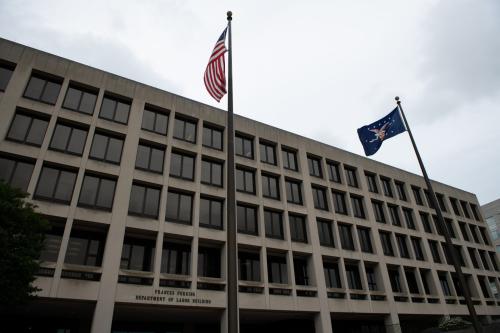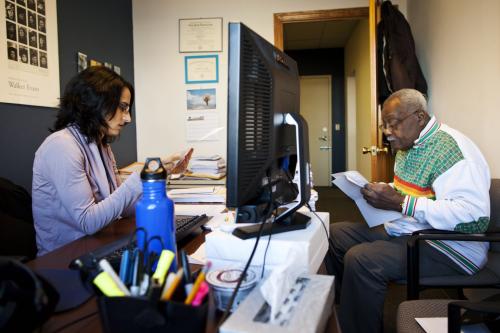The Bureau of Labor Statistics’ October jobs report, released November 5, provides generally positive news with total nonfarm payroll employment increasing by 531,000 compared to an increase of only 194,000 in September, since revised upward. The unemployment rate decreased to 4.6% from 4.8% in September. ManpowerGroup President Becky Frankiewicz said, “This morning’s numbers represent the beginning of a reconciliation between American companies and American workers.” Frankiewicz also suggested that, “As the stimulus ended, employers realized they needed to move closer to what workers want to bring them back in—with higher wages, greater flexibility and more focus on the health and well-being of their people.”
In October, the number of unemployed workers at 7.4 million continued to trend down but is still significantly higher than its level in February 2020, prior to the pandemic, 5.7 million. Both the labor force participation rate and the number of people who were employed part time for economic reasons were little changed from September. In addition to better employment numbers, October also saw an increase in average hourly earnings for all employees on private nonfarm payrolls of 11 cents to $30.96. Frankiewicz said that “employers accept that good wages are now table stakes, and that employees are seeking more flexibility and more purpose in their lives.”
Table 1 shows the unemployment rate by race for the three-month period between August and October. The data show a downward trend in unemployment for white and Latino or Hispanic workers over the three-month period. The unemployment rate for Black and Asian American workers was unchanged from September.

Table 2 shows the U.S. unemployment rate by race, gender, and age from October 2020 to October 2021. The unemployment rate for white and Latino or Hispanic men decreased in October. However, it increased from 8% in September to 8.3% in October for Black men as their labor force participation rate increased by .5 percentage points over September. The labor force participation rate for Black women decreased from 61.2% in September to 60.9% in October and their unemployment rate fell .3 percentage points to 7%. Even in the face of an overall positive trend in the employment situation, October saw an increase in the unemployment rate for Black teens between the ages of 16 and 19 with their unemployment rate increasing from 15.7% in September to 16.1% in October, and this group continued to have the highest 13-month average unemployment rate, 17.28%.

Federal and local vaccine mandates
In October, the number of employed workers who teleworked because of the pandemic declined to 11.6% from 13.2% in September as more workers returned to in-person employment. The number of people who reported that they were unable to work because their employer closed or lost their business due to the pandemic also decreased, from 5 million in September to 3.8 million in October, and 1.3 million people were unable to look for work because of the pandemic. Hence, while we are seeing improvements in the broad employment situation, there is still much progress to be made in the battle against COVID-19.
According to the CDC, as of October 28, 2021, 79.8% of people 18 years of age or older had received at least one dose of the COVID-19 vaccine and 69.2% were fully vaccinated. Of the 62.7% of people who had received at least one dose administered for whom race and ethnicity was known, 17.1% were Hispanic or Latino, 1% were American Indian, 5.9% were Asian American, 10.5% were Black, and 60.6% were white. On November 4, the Biden administration issued an emergency temporary standard to protect unvaccinated employees of large employers. The rule that will cover 84 million workers, approximately 31 million of whom are unvaccinated, and sets a January 4 deadline for large companies with 100 or more employees to mandate COVID-19 vaccinations or begin weekly testing of their workers.
Some municipalities have instituted vaccine mandates to increase the number of people who are vaccinated, leading to tense negotiations with police and other unions. COVID-19 has become the leading cause of death for police officers, with 476 COVID-19 related deaths since the beginning of the pandemic, compared to 94 from gunfire during the same period. On November 4, New York City Mayor Bill de Blasio announced that the city had reached an agreement regarding exemption requests and leave policies with four labor unions regarding the city’s vaccination mandate. Currently, more than 92% of New York City workers under the mandate are vaccinated. In Chicago, Fraternal Order of Police Union President John Catanzara is urging Chicago Police officers to refuse to post their vaccine status on the city’s data portal. On November 1, a Cook County judge granted a temporary restraining order to block a vaccine mandate for union members, preventing the city from firing members of the police union who do not meet a December 31 vaccination deadline.
Federal Reserve bond purchases adjustments
In light of these positive developments in the economy, the Federal Reserve has recently announced that it will begin tapering bond purchases later this month, including a reduction of $10 billion for Treasury securities and $5 billion for agency mortgage-backed securities. The Fed also stated that it anticipates “similar reductions in the pace of net asset purchases will likely be appropriate each month” but noted that “it is prepared to adjust the pace of purchases if warranted by changes in the economic outlook.” Though this move will affect the labor market less than changes to interest rates, it will likely add some slackness into what continues to be a tight labor market.
But while the October jobs report is more optimistic than the one for the previous month, we know that the recovery is not playing out equally across racial lines. And as we argued last month, the Fed should continue to keep the labor market tight in order to promote an inclusive economy with full employment as measured across racial groups rather than simply reflected in the aggregate. This is especially the case given that Federal Reserve Chairman Jerome Powell has noted that the current economic situation in terms of employment and inflation “isn’t the traditional Phillips curve situation where there’s a direct tradeoff” between the two because “the inflation that we’re seeing is really not due to a tight labor market. It’s due to bottlenecks, and it’s due to shortages, and it’s due to very strong demand meeting those.”
We believe that Black unemployment remains far too high to justify a shift in monetary policy that would create slackness in the labor market—a move that would also undercut a burgeoning labor movement that has led to increased wages and leverage for workers demanding better benefits and working conditions.
Conclusion
There is much to celebrate in October’s job report. Employment increased, unemployment fell, and wages rose. These numbers provide further justification for the stimulus-heavy response to the pandemic. Indeed, the current unemployment rate of 4.6% was not matched in the aftermath of the Great Recession of ’08 until February 2017. In addition to these positive trends, almost 80% of the adult population has received at least one dose of the COVID vaccines, and almost 70% of adults are fully vaccinated, which suggests that the disruptive economic effects of the pandemic will continue to decline (hopefully at an accelerating rate).
Nevertheless, labor force participation has remained largely unchanged, as has the unemployment rate for Black workers. And some six million people currently not in the labor force are actively looking for jobs. In addition, pandemic disruptions to key factors including supply chains, childcare access and schooling, and demand for services continue to hold back full economic recovery. Thus, while we have certainly seen significant recovery, we still have a long way to go to achieve full recovery.








Commentary
Despite a strong October jobs report, Black unemployment remains too high to justify the Fed’s recent decision to decrease bond purchases
November 8, 2021